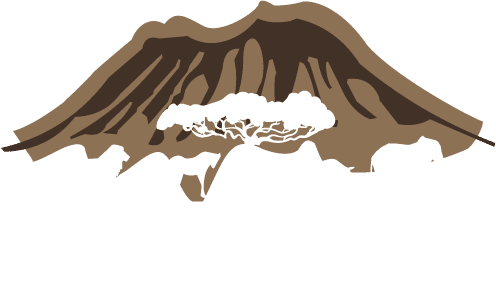Rongai Route 6 Days
- About RONGAI ROUTE
- Rongai route does not allow for the application of the climb high and sleeps low principle. So hikers generally suffer more from altitude sickness on the Rongai route compared to other routes. The Rongai route uses the rock summiting path from Kibo hut to Gilman’s point and descends via the Marangu route.
- The minimum duration for the Rongai route is 6 days, though since the biggest cause of altitude sickness is going too high too fast and it affects every person differently irrespective of their age, fitness levels, etc.
- The starting point of this route is 1,950 m to Rongai’s first cave (2,620m). Rongai is perfect for those who are not confident in their ability to hike over steeper paths. Those who want to avoid traffic or crowd, and those who want to enjoy a quieter hike. When climbing in the rainy season because the north side of the mountain receives less precipitation.
- This route is considered to be one of the easier routes up Kilimanjaro. The climb is both gradual and steady. Though the Rongai Route does not have a great ‘walk high, sleep low’ profile which makes it arguably more difficult than the Machame or Lemosho routes in terms of acclimatization. Climbers prefer 6 and 7-day climbs, with the 7-day option recommended for better acclimatization.
NUMBER OF DAYS
6 Days
EXPECTED DATE
January - December 2022
NUMBER OF PAX
1 to 10
ITINERARY FOR RONGAI ROUTE
DAY 0
Kilimanjaro Airport/Arusha.
Our driver will pick you up from the Kilimanjaro airport (JRO) on your arrival and drop you in Arusha town for overnight.
Accommodation: Mvuli hotel
(We can upgrade the hotel if needed)
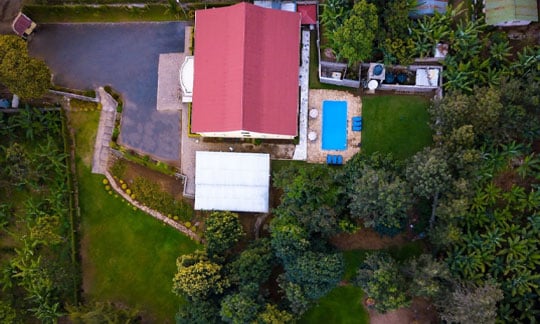
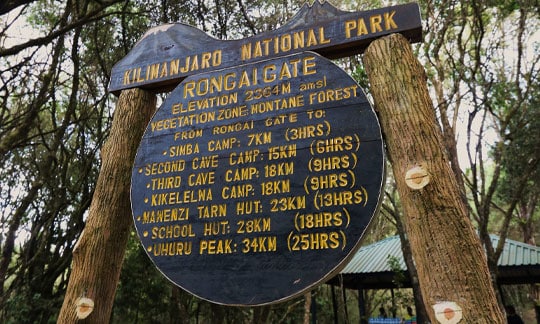
DAY 01
Arusha/Rongai Gate
Transfer takes (about 4-5 hours) to the attractive wooden village of NaleMuru (1950 m / 6398 ft). After signing in and preparing the porters, you will begin the hike on a wide path that winds through fields of maize and potatoes before entering pine forest. The track then starts to climb consistently, but gently through attractive forest that shelters a variety of wildlife.
The forest begins to thin out and the first camp is at the edge of the moorland zone (2600 m / 8530 ft) with extensive views over the Kenyan plains. We use or 4WD min Van/Land cruiser to take you to the gate.
Destination: Rongai gate
Meals: Breakfast, Lunch & Dinner
Accommodation: Simba campsite
DAY 02
Simba/Kikelewa
We hike from Simba camp up towards Kibo till 3 482m for lunch at second Caves, a distance of 5.8km. After lunch we continue trekking until reaching Kikelewa Camp at about 3679 metres. The views start to open up and you begin to feel you’re on a really big mountain! Water can be found in a obvious stream below the cave, although you might have to wander downhill a way to find a pool or two. Enjoy dinner and overnight at Kikelewa camp.
Accommodation: Kikelewa campsite
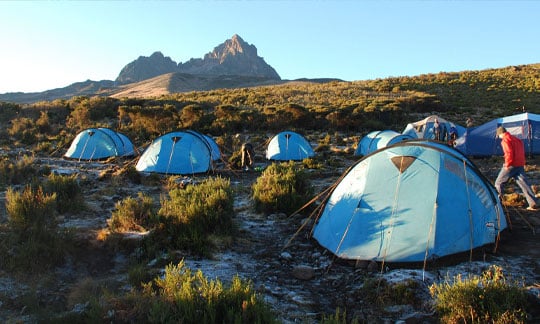
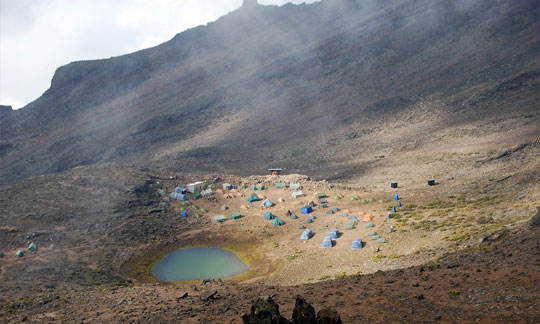
DAY 03
Kikelewa/Mawenzi Tarn
A short but steep climb up grassy slopes offers superb views of this wilderness area. The vegetation zone ends shortly before you reach your next camp at Mawenzi Tarn spectacularly situated beneath the towering spires of Mawenzi. Spend the afternoon acclimatizing and exploring the area.
DAY 04
Mawenzi Tarn/Kibo
After breakfast we head west and continue ascending on the east side of Kibo crossing the saddle between Mawenzi and Kibo taking 4 to 5 hours to reach Kibo Hut. The remainder of the day is spent resting in preparation for the final ascent, which begins around midnight. Overnight at Kibo campsite.
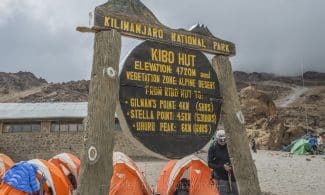
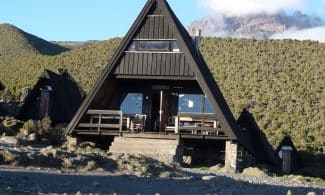
DAY 05
Kibo/Summit and Horombo Hut
You will rise around 23h20, and after some tea and biscuits you shuffle off into the night, and this is where the going really gets tough. The first section of the trail consists of a rocky path to the Hans Meyer Cave (5150m), also a good resting spot.
The path then zigzags up to Gillman’s point (5 681m), which is located on the crater rim. This section is very steep with a lot of stone scree, requiring a great physical and mental effort. This is probably the most demanding section of the entire route. Do the Kili shuffle and move slowly. From Gillmans Point you will normally encounter snow all the way up to Uhuru peak (5895m), the highest point in Africa.
Weather conditions on the summit will determine how long you will be able to spend, taking photographs, before the 3 hour descent back to Kibo hut. After a short rest at Kibo hot, you gather all your gear you left behind for the ascent and head down to Horombo hut (3 hours) for your overnight. The return to Horombo hut will seem surprisingly fast compared to the ascent.
The total time spent walking on this day is around 14 hours, so be prepared for a very tough day. Later in the evening you enjoy your last dinner (with soft drinks and beer for sale at the camp office) on the mountain and a well-earned sleep, filled with memories and stirring emotions.
DAY 6
Horombo/Kilimanjaro airport
After breakfast you continue your descent (6 hours), passing the Mandara hut, down to the Marangu gate. It is strongly recommended not to pay your porters any tips until you and all your gear have reached the gate safely. Click here for more info on tips.
At Marangu gate, you sign your name and details in a register. This is also where successful climbers receive their summit certificates. Those climbers who reached Gillman’s Point (5685m) are issued with green certificates and those who reached Uhuru Peak (5895m), receive gold certificates. Later on, drive to Arusha for some relaxing before dinner and overnight at the lodge.


- PRICES
| Number of Pax | 1-2 pax | 3-4 pax | 5-10 pax |
| Total cost per person on 5 days Kilimanjaro trek via Rongai route in US$ | 2095 | 2052 | 1705 |
Included:
- All Park fees, Meals, hotel before and after the trip in Arusha.
- Accommodations based in dormitory occupancy - Sleeping in the Hut.
- Meals as per the above itinerary – 3 Meals a day – Vegetarians and Non vegetarians.
- Services of Bright Safaris staff throughout. The cook will be responsible for your 3delicious meal daily.
- Services of a Senior Bright African Safaris Naturalist Trekking Guide.
- Baggage handling - Recommended weight for clients’ backpack to be carried up the mountain is 15kgs. Kindly allow 5 kg for personal daypacks including Cameras.
- We will provide guides and assistant guides as per 2008 Kilimanjaro Park rules. Our Guides are licensed and have received special training from Mt. Kilimanjaro National Park Instructors.
- Transfers to the gate before and After Trek to Arusha
- Rescue fee while on Treks.
Not Included:
- Soft drinks, beer, wine and spirits (as well as gifts like local crafts etc)
- Any local and international flights tickets.
- Tips for staff such as guides, porters and the cook staff
- Fees for passport, visas, immunizations and insurance
- Meals and expenses en route to Tanzania
- Laundry, phone and other items of a personal nature
- Gears used for Trekking - Mountain gears such rain gears, boots and jackets etc)
Our Kilimanjaro Team:
- Guides.
- Assistant guides.
- Cooks.
- Camp crews.
- Porters
Notes for our Kilimanjaro staff:
- Our guides are well trained and licensed to guide people on the mountain. They have received a special course on wilderness first aid responder (WFR). Every year in April and May we conduct a special short course for our guides, cooks and porters on hospitality, hygiene and first aid.
- Cooks are very professional with enough experience of over eight years.
- Porters are well equipped and well behave all the time.
Tents we use for our Kilimanjaro treks:
- Eureka.
- Mountain hard wear.
- Vango.
Number of people in the team:
- For 1pax: 6crew: - 4poters, 1guide and 1cook
- For 3pax: 12crew: - 9poters, 2guide and 1cook
- For 5pax: 19crew: - 15poters, 3guide and 1cook
- For 7pax: 26crew: - 21poters, 3guide and 2cook
- For 9pax: 33crew: - 27poters, 4guide and 2cook
- For 2pax: 10crew: - 7poters, 2guide and 1cook
- For 4pax: 15crew: - 12poters, 2guide and 1cook
- For 6pax: 22crew: - 18poters, 3guide and 1cook
- For 8pax: 29crew: - 24poters, 3guide and 2cook
- For 10pax: 36crew: - 30poters, 4guide and 2cook
Below are the Gears we provide:
- Sleeping bags.
- Walking sticks, 1 head lump and spare batteries.
- Getters.
- Sleeping Mattress.
- Drinking water bottle (NALGEN) or camel pack.
- Energy bars.
Safely Devises included:
- Pulse Ox meter.
- Full stocked first aid Kit.
- Custom evacuation stretcher.
- Oxygen tank/cylinder.
- Portable altitude chamber (only for people who do the western breach or sleeping in the crater camp).
Others:
- Full trip and safely briefing.
- Toilet tents.
Budget Camping: Food supplied (Menu)
Breakfast: Fruit, egg, Fruit juice, eggs, bread/French toast/plain toast/pancakes. Margarine/jam/honey/peanut-butter, cereals/porridge, Milo Pancakes, Omelette’s, tea/coffee
Picnic lunches: Sliced carrot & cucumber strips, seasonal fruits, boiled eggs, vegetable/meat cutlets, sandwiches (egg/cheese/tuna/tomato).
Dinners: Soup (Mushroom/cucumber soup, Pumpkin soup/chicken/vegetable) bread, a meat dish, rice/pasta/potatoes, Fish curry/Noodles, vegetable dishes (Vegetable Quiche etc., fruit, some local dishes which am sure they will be more interested to you.
Desserts: Home made cake accompanied with local Brewed Tanzanian coffee, Tea, Cup of hot Chocolate, Milo’s etc.
Snacks: Peanut/Crisps/Popcorn/Cookies.
Below is the list of the gears that you should bring with you/hire before trekking.
FOR FEET: Mt. Boots, Socks – at least 4/5 pairs (This must be thin and thick ones) 1 pair of gaiters, Sandal/open shoes, (optional)
FOR BOTTOM: 1 thermal(warm) trousers, 1 thermal (warm) long underwear, 1 wind/water proof trousers.
FOR TOP: 2 or 1 long sleeved thermal shirts, 1 thermal T-shits, 1 thermal jacket or sweater, 1 down jacket, preferable wool attached one.
OTHER GEARS: 1 pair of sunglasses or ice goggles, Sun block cream or Lotion, Lipstick cream, Camera + films with its spare batteries, passport book, a day pack, a rucksack or safari bag.
Note: Most of the item mentioned here above is 7 – 10 dollars to hire them for the whole Trek.
Let’s us know the items that you will not come with them so as we can arrange them for you in advance.
I am waiting to read from you soon.
